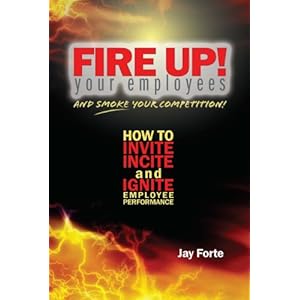The session began with two photos being shown of an attractive man and woman. Forte asked, “Who do you hire?” and I thought to myself whether we were hiring models or not. Forte explained that talent-based interviews are based on how people think, respond, add value, and make a difference within an organization.
GPS was used as an analogy of the “route to profitability”. The route begins with culture, ends with customer loyalty, and employee engagement sits in the middle. I felt that this GPS analogy had more to it but we would be focusing solely on employee engagement. The analogy probably came from his new book that he kept mentioning. In case you are wondering, here it is:
Sixty-five percent of employees are only doing enough to get by. Only 18% are fully engaged. For employees to perform at their full capability, then they must enjoy the work and be good at it. Forte focuses on talents because he believes people don’t really change beyond their youth and most of their brain has developed at a young age. I disagree with both parts because I know that personality tests can vary quite a bit until around middle-age. Also, the brain continues to make changes through-out a person's life and people’s behaviors and talents do change over the years.
The goal of talent-based interviews is to seek out the decisions we make within three seconds. There are 20,000 decisions that people make within 3 seconds. When interviewing someone, we want their immediate reaction because that is reflective of how they will react at work.
The creation of the interview questions is based on the DiSC assessment. Fortunately, I'm familiar with this type of assessment because there was very little explanation given. According to discprofile.com, it is used to show personality and behaviors in 4 categories: dominance, influence, steadiness, and conscientiousness.
Forte went on to explain that a line is drawn across two of the categories that are central to the particular position. The example given was a crew chief that needs to be a leader, driver, bottom-liner, and solver. They went across D and C.
 |
| Forte's DiSC from his SHRM powerpoint slides |
The purpose isn't just to use one particular list of questions but to create a dialogue. I felt this would make it hard to compare the interviews between candidates. However, Forte said that the questions can be the same but are customized by layering them differently. In other words, change the order of questions based on where the interviewee goes with their answer.
I also felt that the use of the word “talent” was misleading since they seemed to be behaviors. Using necessary behaviors to create interview questions is an effective method that is often used. I learned about DiSC in college and was interested in seeing how it can be applied to creating interview questions. One of the flaws is that the interviewer needs to understand how to use DiSC and training would need to be provided to use it accurately. When I completed the DiSC assessment, I was strong in three categories and I wonder if Forte’s method leaves room for people similar to me.

